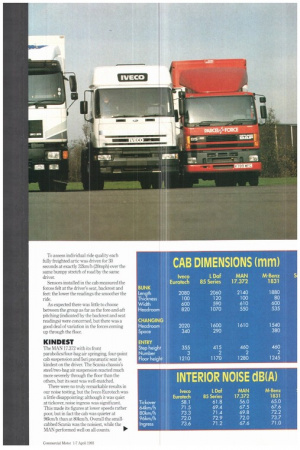SLEEPER CA TEST 1993
Page 30

Page 31

If you've noticed an error in this article please click here to report it so we can fix it.
Throughout the year, come rain or shine, thousands of truck drivers spend nights away from home shacked-up in a cab. Whether this is from choice or necessity may depend on what provision the manufacturer has made for their comfort.
Over the past few years our annual cab test has spotlighted a wide variety of vehicles; as usual we've concentrated on those we haven't looked at before, or which have been improved since we last saw them. This year's group includes two brand new models which will compete head on in the UK: Way) Ford supplied us with a EuroTech straight from the factory, and Parcelforce lent us a preproduction Leyland Daf 85 Series. We have also assessed the full-width version of the MAN F90 cab on a 17.372 tractive unit, alongside another German cab mounted on the Mercedes-Benz 1831 chassis, and we bring ourselves up to date with Scania's Series 3 cab on a P93 tractor.
The old adage that you get what you pay for is as true here as anywhere, so while cab size and trim vary greatly in our sample, cost is always a relevant consideration.
The Iveco Ford EuroTech replaces the old TurboTech soon. The makers stress its roominess, aerodynamic excellence, comfort and safety—to be a winner it will have to demonstrate that the trim stands up to daily wear and tear better than its predecessor's. Not to be outdone, the Leyland Daf 85 Series' all-new wedge-shaped cab claims to offer the same amount of internal space as many outwardly bigger vehicles. The doors wrap into the roof line, uninterrupted by a drip channel, to reduce wind noise. This design feature is followed with the smooth lines of the bonded front screen.
We tried out the narrow version of MAN's F90 cab last year and were interested to see what advantage an extra few centimetres would make to the living room. The alternative German product, Mercedes' L cab, has been around for much longer: how would it stand up to the younger competition?
Scania's Series 3 cab has appeared in an earlier cab test but not, as here, mounted low on the chassis.
A warm, spacious, comfortable bunk might be all that is needed for a good night's sleep, but what about the working day? To find out we measured noise levels and made use of the technology available at MIRA, one of the few test grounds in the world equipped to measure the ride quality of a vehicle.
Over the course of a day's work, most modern artic cabs provide a fairly comfortable environment, but designers have to cope with many factors which are at odds with each other. Road surfaces vary greatly and the compatibility of the chassis suspension with that of the cab and driver's seat plays a major role too. To assess individual ride quality each fully freighted artic was driven for 30 seconds at exactly 32kmih (20mph) over the same bumpy stretch of road by the same driver.
Sensors installed in the cab measured the forces felt at the driver's seat, backrest and feet: the lower the readings the smoother the ride.
As expected there was little to choose between the group as far as the fore-and-aft pitching (indicated by the backrest and seat readings) were concerned, but there was a good deal of variation in the forces coming up through the floor,
KINDEST
The MAN 17.372 with its front parabolicsifour-bag air springing, four-point cab suspension and Isri pneumatic seat is kindest on the driver. The Scania chassis's steel/two-bag air suspension reacted much more severely through the floor than the others, but its seat was well-matched.
There were no truly remarkable results in our noise testing, but the Iveco Eurotech was a little disappointing: although it was quiet at tickover, noise ingress was significant. This made its figures at lower speeds rather poor, but in fact the cab was quieter at 96km/h than at 801(m/h. Overall the smallcabbed Scania was the noisiest, while the MAN performed well on all counts.




















































































